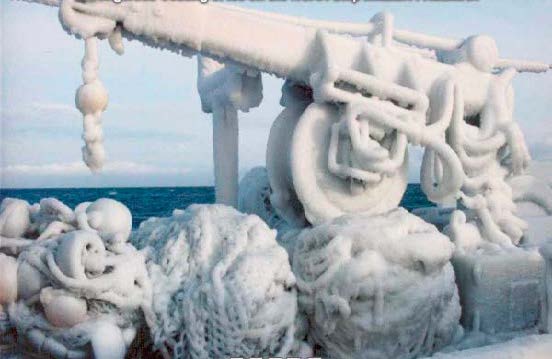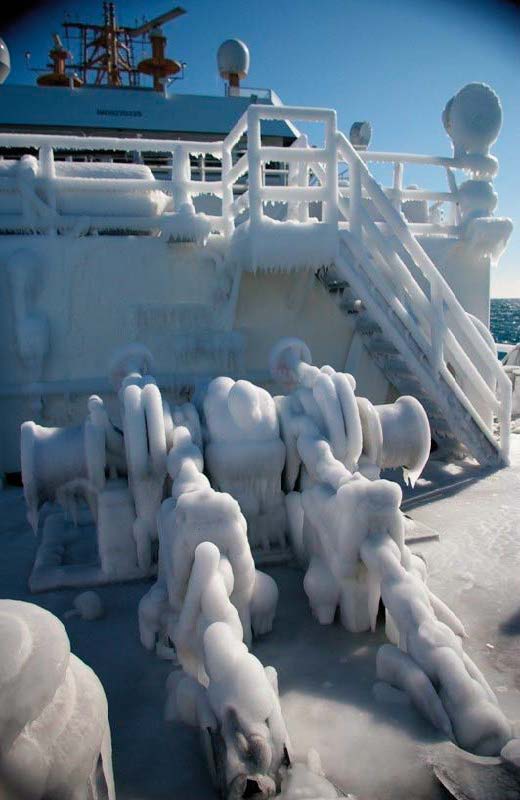WANTED: Freezing Spray and Icing Observations Freezing Spray Project
Ever experience freezing spray conditions on your vessel?
Report it!
To submit an observation, please visit:http://go.usa.gov/WYbm
- Send us your observation:
- Date & Time
- Latitude & Longitude
- Icing conditions
- Air temperature
- Sea conditions
- Wind conditions
- Past Experiences
Freezing spray is an important safety issue in coastal Canadian and United States waters. In an effort to improve freezing spray forecasts, NOAA and Environment Canada are teaming up to evaluate each countryís freezing spray forecast models and tools. Analysis of freezing spray cases, forecaster feedback, and ship observations will allow Environment Canada and NOAA scientists and forecasters to better predict dangerous freezing spray conditions to protect life and property at sea.
The success of this study depends on you: Whenever possible, please report icing conditions to NOAA and Environment Canada Send reports online:

Ice accumulated on NOAA Ship OSCAR DYSON Photo credits: NOAA Office of Marine and Aircraft Operations
The Freezing Spray Project
For many mariners, the threat of freezing spray is treated very seriously. The combined forces of the ocean, wind, and cold temperatures can result in a very dangerous situation for vessels caught up in the elements. When these forces work together under the right conditions, ice accretion can reduce a vesselís stability and the results can be devastating. The fishing vessel LADY OF GRACE was one such example where ice accretion caused the vessel to capsize, killing all four people aboard in 2007.

Ice accumulated on NOAA Ship OSCAR DYSON Photo credits: NOAA Office of Marine and Aircraft Operations
The National Weather Service (NWS) and Environment Canada (EC) routinely forecast freezing spray conditions between October and March in the higher latitudes. James Kells, Senior Marine Forecaster from the NWS's Ocean Prediction Center, stated, ďThe hazard created by freezing spray is a common occurrence during the cold weather months in the high latitudes.Ē Last year alone, the National Weather Service issued over three thousand freezing spray warnings.
Because of the life threatening conditions and the complexity of freezing spray forecasting, EC and the NWS teamed up to understand how these conditions are being forecasted and are looking for ways to improve.
To date, this joint collaborative effort has succeeded in modifying the Overland model (Overland 1990) and has introduced different models, such as Sawada (nomogram) and the Modified Stallabrass model (Stallabrass 1980) to forecasting offices. Each model handles the physics of freezing spray differently. For example, Overland was developed to forecast categorical icing rates (light, moderate, severe) and has a sensitivity to low sea surface temperatures and is highly driven by changes in air temperature. Stallabrass requires additional weather parameters such as wave and relative humidity information and uses a vesselís speed and height to calculate spray flux, an important parameter that includes how the spray freezes onto a vesselís structure. Having each of these models available and understanding the inputs broadens a forecasterís perspective and gives them more options to consider before making their predictions.
The project is also making efforts to compare and understand the strengths and weaknesses of these existing models. To do this, forecasting tools have been developed that allow forecasters to visualize the differences between models within the Graphical Forecast Editor that is used by every NWS office. The guidance provided by the existing freezing spray models can now be easily displayed and compared. They can also be saved in order to investigate events that may be recorded later.
The difficult situation we are in now is verifying the models and our forecasts. This is usually a straightforward process because many vessels provide meteorological observations. However, during the course of this project, NOAA and EC quickly realized that most mariners heed freezing spray warnings and stay tied up at the pier or they do not report it. Without observations, our ability to improve the current forecasting capabilities is limited.
To thoroughly evaluate the different computer models that predict freezing spray, the team needs to know what conditions actually developed during icing events. Every observation submitted during this study will provide critical insight into model performance, strengths and weaknesses. Each observation is a step towards enhancing the ability of each agency to protect life and property at sea.
The success of this project depends on you and the entire maritime industry: whenever possible, please report icing conditions to NOAA and Environment Canada!
Back to top
